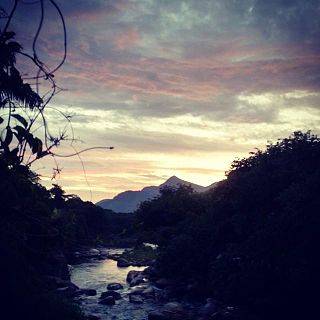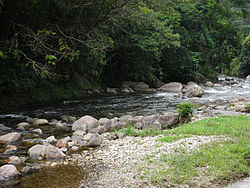Nova Iguaçu is a municipality in Rio de Janeiro state in Brazil.

Paulo Afonso is a city in Bahia, Brazil. It was founded in 1958.

Itaboraí is a city in the state of Rio de Janeiro in Brazil, that belongs to the Rio de Janeiro metropolitan area. It was founded in 1672. In 2020, it had a population of 242,543.

Cachoeiras de Macacu is a municipality located in the Brazilian state of Rio de Janeiro. Its population was 59,303 (2020) and its area is 956 km². Next to neighboring Rio Bonito municipality, it can be considered an exurb of Greater Rio de Janeiro metropolis.

Casimiro de Abreu is a municipality located in the Brazilian state of Rio de Janeiro. Its population was 45,041 (2020) and its area is 461 km².

Guapimirim, is a Brazilian Municipality in the state of Rio de Janeiro around 50km(31 miles) from its state capital, the city of Rio de Janeiro. Its in a region known as Baixada Fluminense and the Greater Rio de Janeiro metropolitan area.

Silva Jardim is a municipality located in the Brazilian state of Rio de Janeiro. Its population was 21,774 (2020) and its area is 938 km².

Tinguá Biological Reserve is a biological reserve in the Serra do Tinguá mountains, Rio de Janeiro state, eastern Brazil.

Tamoios Ecological Station is a coastal marine ecological station in the state of Rio de Janeiro, Brazil.

Petrópolis Environmental Protection Area is a protected area of Rio de Janeiro state, Brazil.

Guapimirim Environmental Protection Area is a coastal marine protected area on Guanabara Bay in the state of Rio de Janeiro, southeastern Brazil.

The Jamanxim River is a river of Pará state in north-central Brazil. Originating in the Serra do Cachimbo, it is a tributary of the Tapajós, into which it flows a few kilometers upstream from Itaituba.

The Guaxindiba River is a river of Rio de Janeiro state in southeastern Brazil.

The Central Rio de Janeiro Atlantic Forest Mosaic (Portuguese: Mosaico da Mata Atlântica Central Fluminense is a protected area mosaic in the state of Rio de Janeiro, Brazil. The mosaic is inland, to the east of the city of Rio de Janeiro.

The Três Picos State Park is a state park in the state of Rio de Janeiro, Brazil. It preserves a large, mountainous region of Atlantic Forest.

The Paraíso Ecological Station was an ecological station in the state of Rio de Janeiro, Brazil. In 2013, it was absorbed into the Três Picos State Park.

The Guanabara Ecological Station is an ecological station in the state of Rio de Janeiro, Brazil. It protects an area of mangroves in Guanabara Bay, not far from the city of Rio de Janeiro.

The Maravilha Environmental Protection Area is a municipal environmental protection area in the state of Rio de Janeiro, Brazil.

The Bacia do Rio Macacu Environmental Protection Area is an environmental protection area in the state of Rio de Janeiro, Brazil.

The Frades River is a river in the state of Bahia, Brazil.













